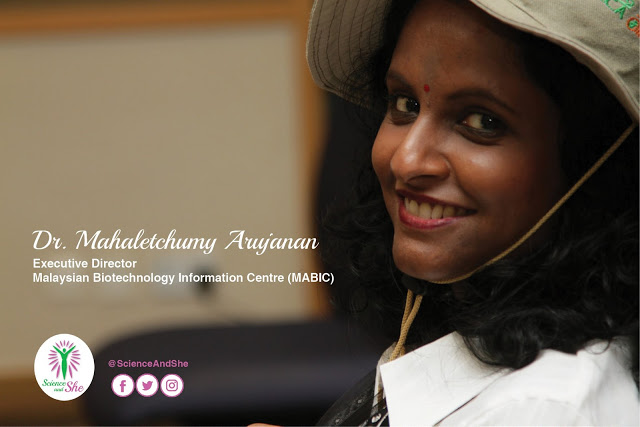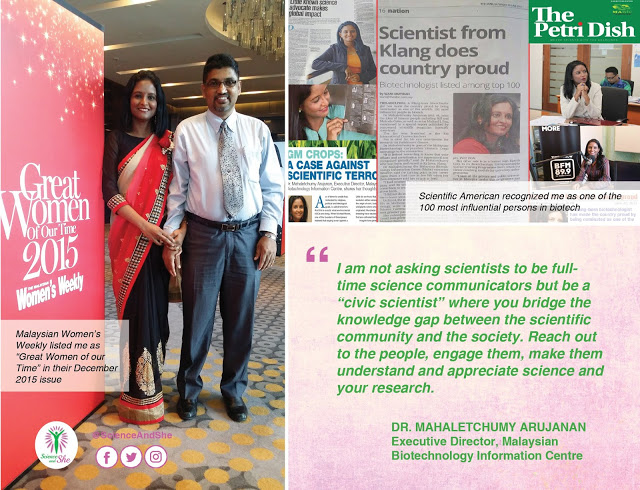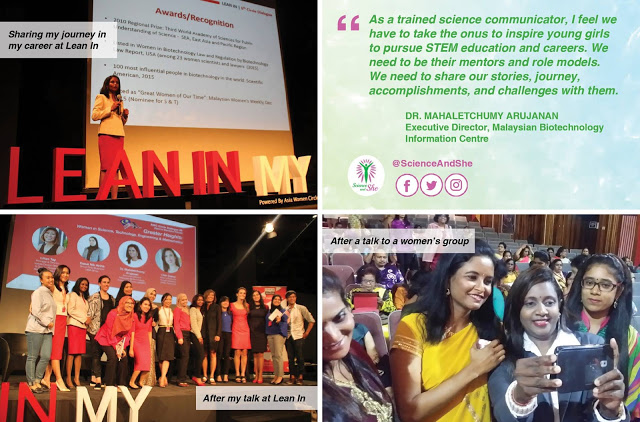Science and She: Dr. Mahaletchumy Arujanan
| |
The International Service for the Acquisition of Agri-biotech Applications (ISAAA) and its network ofBiotechnology Information Centers launched a campaign on social media whichaims to empower women in science. The campaign called Science and She,features scientists and science communicators who tell their stories andaspirations for science and the society with the hope that the stories willhelp bridge the gap between science and the public.
For each week, one female scientist orscience communicator serves as the curator of the Science and She socialmedia pages on Facebook, Twitter, and Instagram. Recently, Dr. Mahaletchumy Arujanan, a science communicationexpert and Executive Director of the Malaysian Biotechnology Information Center, took thecenterstage.

According to Dr. Arujanan, sciencecommunication is relatively a new field and so much needs to be done in thisarea in the developing world. She calls on scientists to be “civic scientists” tobridge the knowledge gap between the scientific community and the society. Sheencouraged them to reach out to the people, engage them, make them understandand appreciate science and research.
Recognitions
Empoweringothers with scientific knowledge and helping them to make informed decisions gives Dr. Maha a tremendous satisfaction. Her contributionsto science communication were first recognized by The World Academy of Sciences(TWAS) with the awarding of the 2010 TWAS Regional Prize for PublicUnderstanding of Science for East, SEA and the Pacific Region. Anotherrecognition came in 2015, when Scientific American’s WorldView named heras one of the 100 most influential persons in biotech in the world. Inthe same year, Biotech Law Report published by Mary Ann Liebert in the USA listedDr. Arujanan as one of the women in Biotech Law and Regulations. MalaysianWomen’s Weekly also listed her as one of the “Great Women of our Time” in theirDecember 2015 issue.

Theimportance of science communication
"Communicatingand engaging the public with science and biotechnology is crucial. To makeinformed decisions, every individual needs some basic understanding of science.And this is exactly what we do at the Malaysian Biotechnology Information Centre(MABIC)...we empower the public with scientificknowledge. Join us in our rally to support science and science-based decisions,"says Dr. Arujanan.This is the reason why she loves herjob as a science communicator. “It's really fulfilling to see that my jobtranslates into science-based policies, regulations, and it helps to ensurefood security, mitigate climate change, have sustainable agriculturalpractices, and in the alleviation of poverty…I’m a strong advocate ofbiotechnology. I strongly believe that if this field is deployed ethically, itcan solve many of the problems that we face today," she added.
Dr.Arujanan emphasized that at present, there are several means to disseminateinformation on science/biotechnology and to engage the public. We do not haveto solely depend on the mainstream media. While MABIC resorted to creating aprint media that has been digitalized, social media offers another powerfultool as a mouthpiece for scientists and science communicators. Their monthlynewspaper, The Petri Dish, is the first science newspaper in Malaysia, distributed to major universities,research institutes, hospitals, government agencies, government ministries andschools across Malaysia aswell as in Indonesia.She also reaches out to the public, especially to the young minds, through her Facebook page which has over 12,000 followers as of this writing.
Women in STEM
Dr.Arujanan recognized the tremendous increase in the number of women in sciencecareers such as scientists, engineers, mathematicians, and professionals inother STEM-related areas. According to her, this is really an achievement of progressivepolicies, government measures, and also the society that allowed women topursue their dreams around the world.
“Butthe truth is we have not achieved equality yet with our male counterparts.While the number of girls is increasing in the universities, there is still a leaky pipe somewhere alongthe career path. We still do not see enough women at the pinnacle oforganizations, at the decision-making positions and in the boardrooms,” shehighlights.
“As a trained sciencecommunicator, I feel we have to take the onus to inspire young girls to pursueSTEM education and careers. We need to be their mentors and role models. Weneed to share our stories, journey, accomplishments, and challenges with them.More importantly, we need to stand up for our rights so we pave a road that iswith fewer obstacles for the next generation. So that, their journey becomessweeter than ours and they could contribute much more than us,” Dr. Arujananstressed.

| Newer Post | Archive |
Science Speaks is ISAAA Inc.'s official blog. Weekly blog articles, authored by ISAAA writers, partners, and invited contributors, aim to help share, disseminate, and promote scientific knowledge and its vital role in achieving global agricultural sustainability and development. Your support to Science Speaks will help us achieve this goal. You can help us by donating as little as $10.

